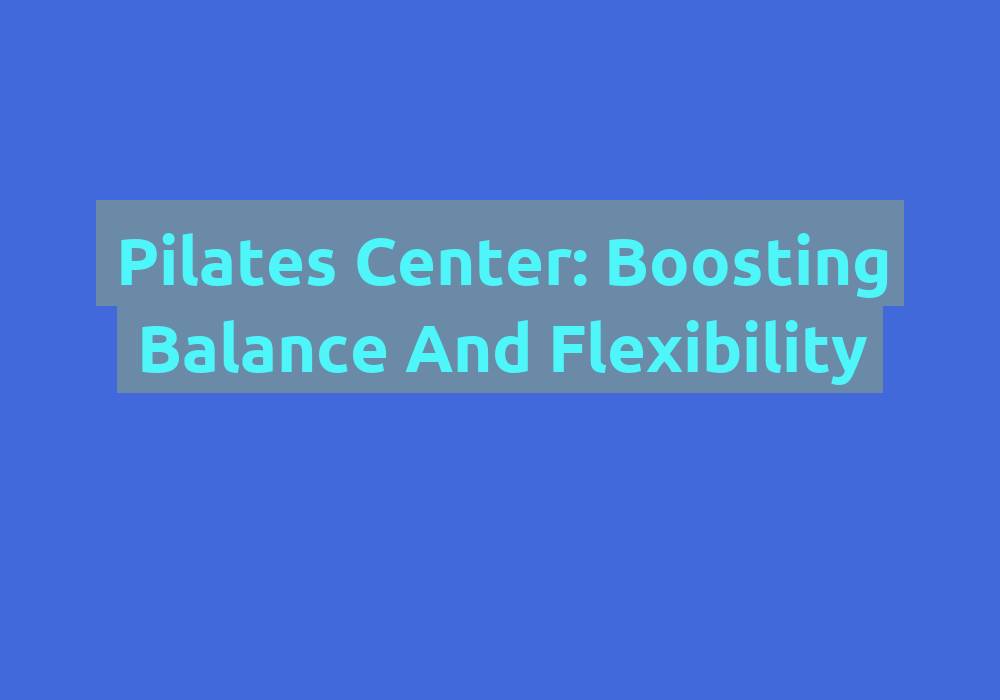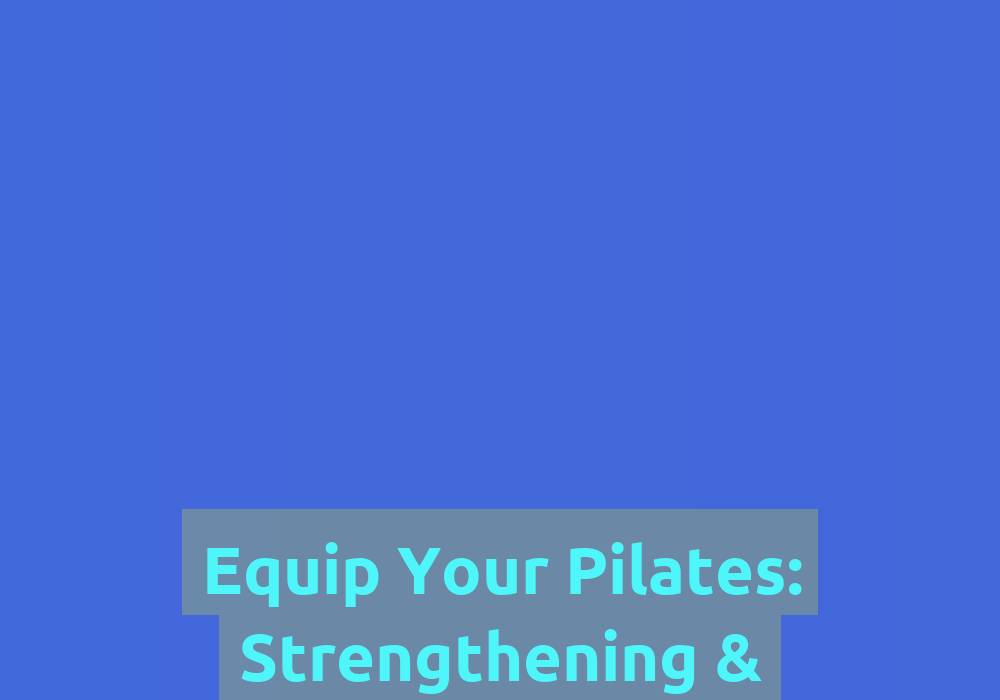Pilates Center: Boosting Balance and Flexibility

Pilates is a popular exercise method that focuses on improving flexibility, strength, and overall body awareness. The Pilates Center, as the name suggests, is a dedicated facility where individuals can embrace this transformative practice and experience numerous benefits. In this article, we will explore the world of Pilates, its impact on balance and flexibility, and why the Pilates Center is an ideal place to nurture these attributes.
Understanding Pilates
Pilates is a low-impact exercise system that aims to strengthen the body’s core muscles, enhance flexibility, and improve posture. It was developed by Joseph Pilates in the early 20th century and has since gained immense popularity worldwide. The exercises in Pilates focus on controlled movements and conscious breathing, which help improve body alignment and promote a sense of balance and grace.
Pilates is not just about physical fitness, but also about developing mental focus and body awareness. The practice encourages individuals to be mindful of their movements, paying attention to the alignment and engagement of specific muscles. By doing so, individuals can achieve better body control and coordination.
Unleashing the Power of Balance
Balance plays a crucial role in our daily lives, whether it’s maintaining stability while standing, walking, or engaging in physical activities. Pilates is known for its ability to enhance balance through specific exercises that target the core muscles, including the deep stabilizing muscles of the abdomen and back.
One of the key principles of Pilates is the activation of the body’s powerhouse, which refers to the muscles of the abdomen, lower back, hips, and buttocks. Strengthening these muscles helps improve core stability, which is essential for maintaining balance in various movements and activities.
Pilates exercises also focus on improving proprioception, which is the body’s ability to sense its position and movement in space. By increasing proprioception, individuals can better control their body’s position and make adjustments to maintain balance. This improved sense of balance not only enhances physical performance but also reduces the risk of falls and injuries.
In addition to the physical benefits, Pilates also promotes mental balance and stability. The mindful and focused nature of the practice helps individuals develop a sense of calmness and clarity, which can translate into improved overall wellbeing.
Elevating Flexibility to New Heights
Flexibility is another key component that Pilates focuses on. Through a combination of stretching, lengthening exercises, and controlled movements, Pilates can significantly improve flexibility, allowing individuals to move more freely and perform daily activities with ease.
Pilates exercises specifically target tight and overactive muscles, helping to release tension and increase range of motion. The controlled movements and emphasis on proper alignment in Pilates promote lengthening and elongation of muscles, which leads to improved flexibility over time.
Increased flexibility not only enhances range of motion but also helps prevent injuries, reduces muscle tension, and improves overall athletic performance. When the body is more flexible, it can move with greater efficiency and less strain, leading to improved functionality in daily life and other physical activities.
Benefits of Pilates for Balance and Flexibility
-
Core Strength: Pilates emphasizes core strength, which plays a vital role in maintaining balance and stability. By targeting the deep abdominal and back muscles, Pilates helps individuals develop a strong core, providing a solid foundation for improved balance and flexibility.
- Strengthening the core muscles helps support the spine and maintain proper alignment, which is essential for balance.
- A strong core also improves posture, reducing the risk of muscular imbalances that can negatively affect balance.
-
Improved Posture: Poor posture can negatively impact balance and flexibility. Pilates exercises are designed to correct postural imbalances and promote proper alignment. By strengthening the muscles responsible for maintaining good posture, Pilates helps individuals stand taller, breathe more efficiently, and move with greater fluidity.
- Pilates focuses on strengthening the muscles of the upper back, shoulders, and neck, which are often weakened and imbalanced due to poor posture.
- Proper alignment and posture improve the body’s ability to distribute weight evenly, enhancing balance and stability.
-
Muscle Coordination: Pilates incorporates movements that require coordination between various muscle groups, enhancing the body’s overall strength and balance. By training the body to move in a unified and coordinated manner, Pilates helps individuals improve their proprioception (awareness of one’s body in space) and achieve better overall balance.
- Pilates exercises often involve multi-directional movements that challenge coordination and balance.
- By improving muscle coordination, individuals can perform movements with greater control and fluidity, reducing the risk of falls and injuries.
-
Increased Joint Mobility: Pilates exercises often involve gentle stretching and controlled movements, which help improve joint mobility. By promoting healthy joint range of motion, Pilates allows individuals to move more freely and with less pain, enhancing both balance and flexibility.
- Pilates exercises focus on mobilizing the spine, hips, shoulders, and other major joints, improving their range of motion.
- Increased joint mobility reduces stiffness and improves the body’s ability to adapt to different movements and positions, enhancing balance and flexibility.
-
Mind-Body Connection: Pilates places a strong emphasis on the mind-body connection. By engaging the mind in each movement and focusing on breath control, individuals can achieve a deeper level of concentration and body awareness. This mindful approach enhances balance and flexibility by promoting better alignment, control, and movement precision.
- Mindful movement in Pilates helps individuals develop a heightened awareness of their body’s position, alignment, and movement patterns.
- By focusing on the body’s sensations and movements, individuals can make adjustments to improve balance and flexibility.
Why Choose the Pilates Center?
The Pilates Center is an ideal place to embark on your journey towards improved balance and flexibility. Here’s why:
-
Expert Guidance: The Pilates Center is staffed with experienced and certified instructors who possess in-depth knowledge of the Pilates method. These experts can guide you through the exercises, ensuring proper form and technique, and tailoring the sessions to your individual needs and goals.
- The instructors at the Pilates Center have undergone extensive training and have a deep understanding of the Pilates principles and techniques.
- Their expertise allows them to provide personalized guidance and modifications to accommodate different fitness levels and specific needs.
-
State-of-the-Art Equipment: The Pilates Center is equipped with top-of-the-line Pilates apparatus, including reformers, cadillacs, and chairs. These specialized equipment offer additional resistance and support, allowing for a more challenging and effective workout that enhances both balance and flexibility.
- The use of specialized Pilates equipment adds variety and intensity to the workouts, helping individuals progress and achieve their goals.
- The equipment provides targeted resistance, allowing for specific muscle groups to be isolated and strengthened, further enhancing balance and flexibility.
-
Personalized Programs: At the Pilates Center, personalized programs are designed to address each individual’s unique needs and goals. Whether you’re a beginner or an advanced practitioner, the instructors will create a program that optimizes your progress and helps you reach new heights of balance and flexibility.
- The instructors at the Pilates Center take the time to assess individual strengths, weaknesses, and goals, tailoring the programs accordingly.
- Personalized programs ensure that individuals receive the appropriate level of challenge and progression, maximizing the benefits for balance and flexibility.
-
Supportive Community: The Pilates Center provides a nurturing and supportive environment where individuals can connect with like-minded people who share a passion for Pilates and wellbeing. This community atmosphere fosters motivation, accountability, and camaraderie, enhancing the overall experience and commitment to achieving balance and flexibility.
- The supportive community at the Pilates Center creates a sense of belonging and encouragement, making the journey towards improved balance and flexibility more enjoyable.
- Interacting with others who are on a similar path can provide inspiration, support, and valuable insights, further enhancing the overall experience.
In conclusion, Pilates is a highly effective exercise method for boosting balance and flexibility. The Pilates Center offers a comprehensive approach to cultivating these attributes, with expert guidance, specialized equipment, personalized programs, and a supportive community. By embracing Pilates at the Pilates Center, individuals can embark on a transformative journey towards improved physical and mental wellbeing.
FAQ
-
What is Pilates?
- Pilates is a low-impact exercise system that focuses on improving flexibility, strength, and overall body awareness. It involves controlled movements and conscious breathing to improve body alignment and promote balance and grace.
-
How does Pilates enhance balance?
- Pilates enhances balance by targeting the core muscles, including the deep stabilizing muscles of the abdomen and back. Strengthening these muscles improves core stability, which is essential for maintaining balance in various movements and activities. Pilates also improves proprioception, the body’s ability to sense its position and movement in space, allowing for better control and adjustments to maintain balance.
-
How does Pilates improve flexibility?
- Pilates improves flexibility through stretching, lengthening exercises, and controlled movements. It specifically targets tight and overactive muscles, releasing tension and increasing range of motion. The emphasis on proper alignment and controlled movements promotes lengthening and elongation of muscles, leading to improved flexibility over time.
-
What are the benefits of Pilates for balance and flexibility?
- The benefits of Pilates for balance and flexibility include improved core strength, better posture, enhanced muscle coordination, increased joint mobility, and a heightened mind-body connection. Pilates strengthens the core muscles, supports the spine, and improves posture, all of which contribute to better balance. It also enhances overall muscle coordination and joint mobility, reducing the risk of falls and injuries. The mindful approach in Pilates improves alignment, control, and movement precision, enhancing balance and flexibility.

